Author: Jacob Zhao
Recently, the cryptocurrency market has been lackluster, and conservative and stable returns have once again become a market demand. Therefore, combining my investment insights from recent years and concentrated research on the stablecoin sector at the end of last year, I would like to discuss the age-old yet evergreen topic of stablecoin yields.
The current categories of stablecoins in the cryptocurrency market mainly include the following:
- USDT: The most widely used stablecoin with conditional compliance: Its application scenarios are broad enough (trading pairs on exchanges, salary payments for crypto industry companies, real international trade, and offline payment scenarios), and users hope for a large stablecoin that cannot fail, with Tether having the ability to back it up.
- Regulated stablecoins pegged 1:1 to fiat currencies: USDC has the most chain and application support, making it a true on-chain dollar, while other regulated stablecoins like PayPal USD and BlackRock USD have certain limitations in their application scenarios.
- Over-collateralized stablecoins: Primarily represented by MakerDAO's DAI and its upgraded version USDS after becoming Sky Protocol; Liquity's LUSD has become a competitor with its zero-collateral lending rate and 110% low collateralization ratio.
- Synthetic asset stablecoins: The most representative in this cycle is the phenomenal USDe from Ethena. Its yield generation model through funding rate arbitrage will also be one of the stablecoin yield models analyzed in this article.
- RWA project stablecoins backed by U.S. Treasury assets: The most representative in this cycle are Usual's USD0 and Ondo's USDY. Usual's USD0++ provides liquidity for U.S. Treasuries, similar to how Lido does for ETH staking, showcasing innovation.
- Algorithmic stablecoins: After the collapse of Terra's UST, this category has been largely discredited. Luna lacked real value support, leading to severe price volatility and a death spiral of sell-offs and crashes. FRAX combines algorithmic stablecoin and over-collateralization models, still having some application scenarios, while other algorithmic stablecoins have lost market influence.
- Non-U.S. dollar stablecoins: Euro stablecoins (Circle's EURC, Tether's EURT, etc.) and other fiat stablecoins (BRZ, ZCHF, HKDR, etc.) currently have minimal impact on the U.S. dollar-dominated stablecoin market. A non-U.S. dollar over-collateralized stablecoin project I previously invested in has essentially gone to zero. The only way forward for non-U.S. dollar stablecoins lies in payment services under a compliant regulatory framework rather than applications in the native crypto community.
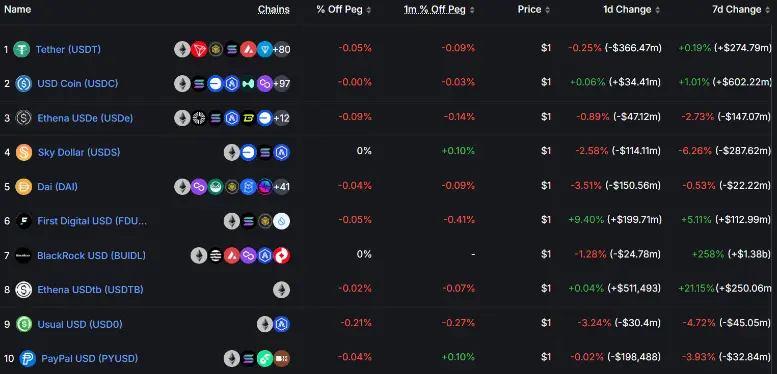
Stablecoin Market Capitalization Rankings
Data Source: https://defillama.com/stablecoins
Currently, the main categories of yield generation through stablecoins are as follows, and this article will further analyze each type of yield in detail:
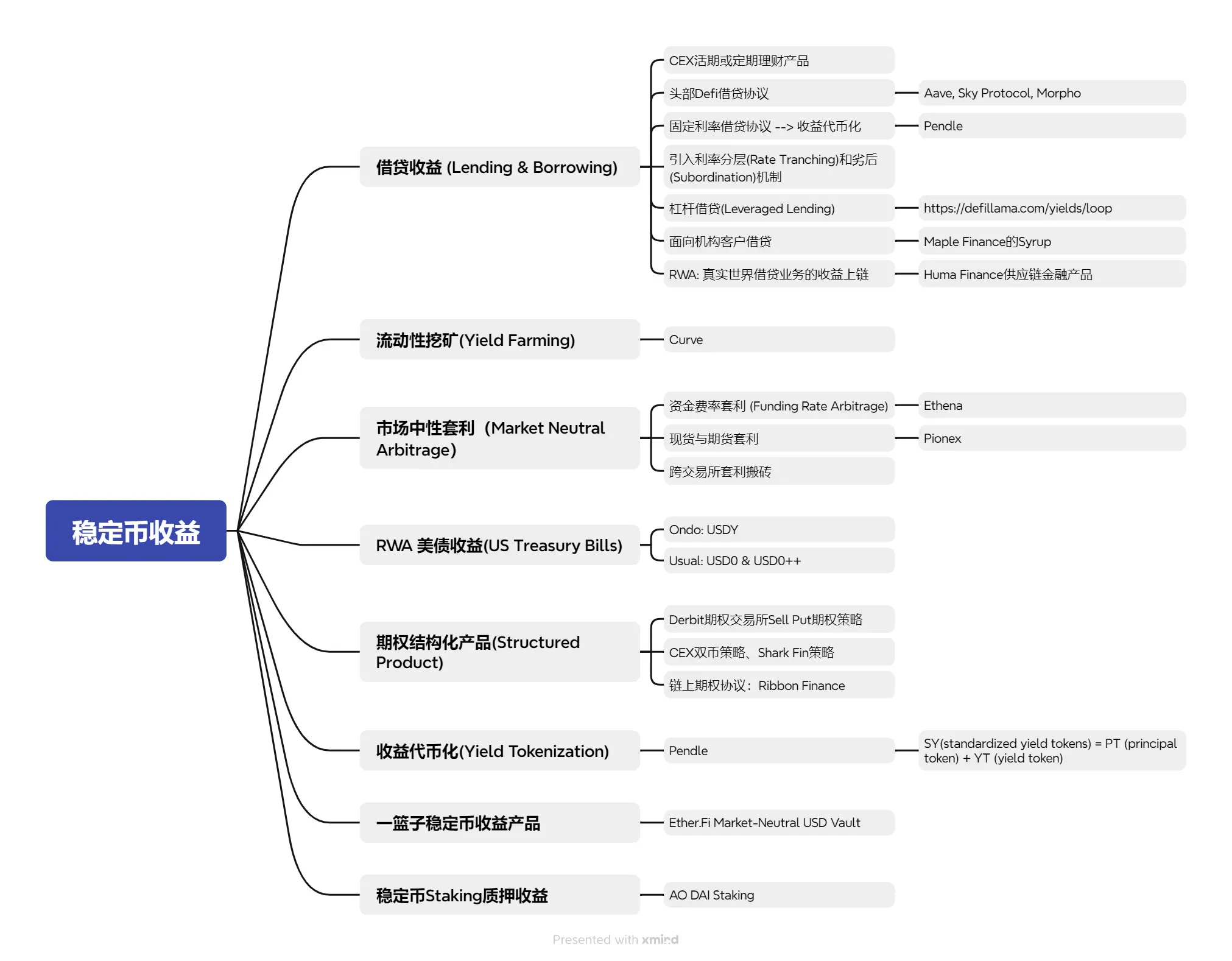
1. Stablecoin Lending & Borrowing:
Lending and borrowing, as the most traditional financial yield model, derive their returns from the interest paid by borrowers. It is essential to consider the security of the platform or protocol, the probability of borrower default, and the stability of returns. Current stablecoin lending products in the market include:
- CeFi platforms primarily focus on savings products from leading exchanges (Binance, Coinbase, OKX, Bybit).
- Leading DeFi protocols include Aave, Sky Protocol (the rebranded MakerDAO), Morpho Blue, etc.
The platform security of leading exchanges that have undergone cyclical tests and the security of leading DeFi protocols are relatively high. During bullish market periods, the demand for lending can easily drive U's flexible interest rates above 20%, but during quiet market periods, returns generally remain low, around 2%-4%. Therefore, flexible interest rates are also a straightforward indicator of market activity. Fixed interest rate lending sacrifices liquidity, so it generally yields higher returns than flexible rates, but it cannot capture the spikes in flexible rates during active market periods.
Additionally, there are some minor innovations in the overall stablecoin lending market, including:
- Fixed-rate lending DeFi protocols: The Pendle protocol, which started with fixed-rate lending and evolved into yield tokenization, is highly representative of this cycle. Early fixed-rate DeFi projects like Notional Finance and Element Finance, although they did not succeed, have design concepts worth referencing.
- Introducing rate tranching and subordination mechanisms in lending;
- Providing leveraged lending DeFi protocols;
- DeFi lending protocols aimed at institutional clients, such as Maple Finance, where Syrup's yield comes from institutional lending.
- RWA projects bringing real-world lending yields on-chain, such as Huma Finance's on-chain supply chain finance products.
In summary, lending business, as the most traditional financial yield model, is straightforward and will continue to be the primary stablecoin yield model due to its capacity to handle large amounts of capital.
2. Yield Farming Returns:
Represented by Curve, its yields come from AMM trading fees distributed to LPs and token rewards. Curve, as the holy grail of stablecoin DEX platforms, has stablecoins supported in Curve Pools as an important indicator of new stablecoins' adoption in the industry. The advantage of Curve mining lies in its high security, while its drawback is the low and unattractive yields (0-2%). If non-large and long-term funds participate in Curve's liquidity mining, the returns may not even cover transaction gas fees.
Uniswap's stablecoin pool trading pairs face the same issue, as non-stablecoin trading pairs on Uniswap may incur losses from liquidity mining. Other smaller DEX stablecoin pool trading pairs, even with higher yields, still raise concerns about rug pulls, which do not align with the cautious and stable principles of stablecoin investment. We can see that DeFi stablecoin pools are still primarily based on lending models, with Curve's classic 3Pool (DAI USDT USDC) only ranking in the top twenty by TVL.
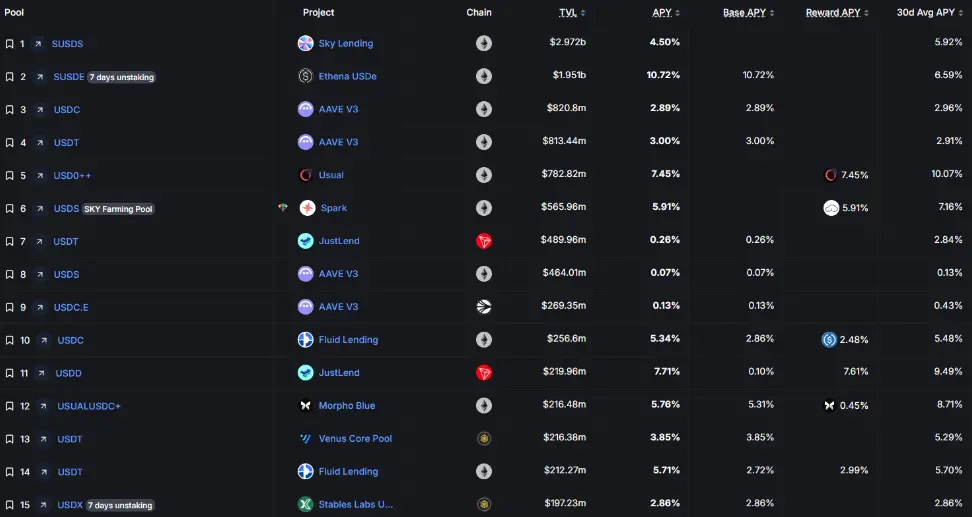
Stablecoin Pool TVL Rankings
Source: https://defillama.com/yields?token=ALLUSDSTABLES
3. Market Neutral Arbitrage Returns:
Market-neutral arbitrage strategies have long been widely used by professional trading institutions. By simultaneously holding long and short positions, the net market exposure of the investment portfolio approaches zero. Specifically in crypto, the main strategies include:
Funding Rate Arbitrage: Perpetual futures have no expiration date, and their prices are kept in line with spot prices through a funding rate mechanism. The funding rate needs to be paid periodically, shortening the short-term price difference between spot and perpetual contracts.
When the perpetual contract price is higher than the spot price (contango), longs pay shorts, and the funding rate is positive.
When the perpetual contract price is lower than the spot price (backwardation), shorts pay longs, and the funding rate is negative.
Historical data shows that the probability of a positive funding rate is long-term greater than that of a negative funding rate. Therefore, the yield primarily comes from buying spot in a positive funding rate scenario and shorting perpetual contracts, collecting fees paid by longs.
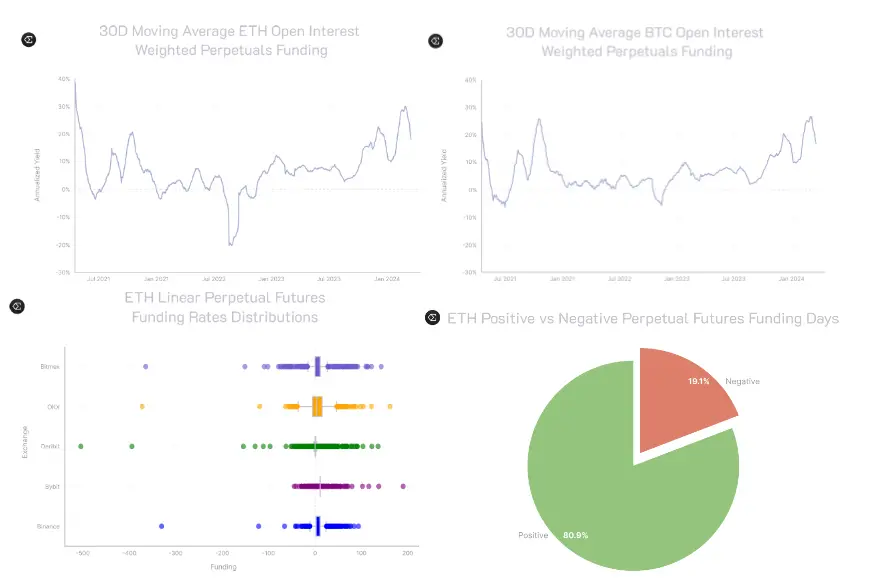
- Cash-and-Carry Arbitrage: This strategy utilizes price differences between the spot market and the futures market to lock in profits through hedged positions. The core concept is "basis," which is the difference between the futures price and the spot price at expiration. It is typically operated in contango (futures price higher than spot) or backwardation (futures price lower than spot) markets. Cash-and-carry arbitrage is suitable for investors with large capital who can accept a lock-up period and are optimistic about basis convergence, commonly seen among traders with traditional financial thinking.
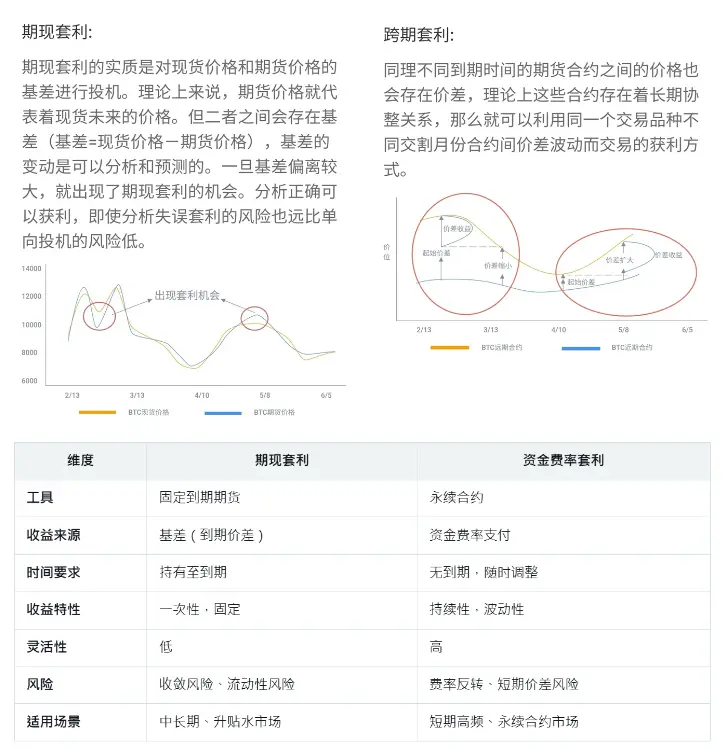
Cross-Exchange Arbitrage: This involves utilizing price differences between different exchanges to construct neutral positions. It was a mainstream arbitrage method in the early days of the crypto industry, but currently, the price differences for mainstream trading pairs across different exchanges are minimal. It requires automated arbitrage scripts and is more suitable for high-volatility markets and small-cap coins, making it challenging for retail investors to participate. The Hummingbot platform can be referenced for this purpose.
Additionally, there are triangular arbitrage, cross-chain arbitrage, and cross-pool arbitrage strategies in the market, which will not be further elaborated on in this article.
Market-neutral arbitrage strategies are highly specialized, limiting their audience primarily to professional investors. However, the emergence of Ethena in this cycle has brought the "Funding Rate Arbitrage" model on-chain, allowing ordinary retail users to participate.
Users deposit stETH into the Ethena protocol to mint an equivalent amount of USDe tokens, while simultaneously opening an equivalent short position on a centralized exchange to earn positive funding rates. According to historical statistics, over 80% of the time, the funding rate is positive, and in scenarios with negative funding rates, Ethena compensates for losses through reserves. Over 65% of Ethena's income hedges funding rates, and there are also supplementary earnings from Ethereum staking and on-chain or exchange lending (35%); additionally, user assets are held by a third-party custodian OES (Off Exchange Settlement) and regularly audited, effectively isolating exchange platform risks.

Regarding the risks of Ethena, aside from uncontrollable factors such as exchange platform and custodian incidents, smart contract security issues, or the decoupling of pegged assets, a more critical point lies in the "losses in long-term negative funding rate scenarios that cannot be covered by the protocol's reserved funds." Based on historical data, we can understand this as a low probability event. Even if it occurs, it would mean the failure of the widely applicable "funding rate arbitrage" trading strategy in the industry. Therefore, under the premise that the team does not act maliciously, the Ethena protocol is unlikely to experience the death spiral model of Terra's algorithmic stablecoin. Instead, what may happen is a gradual decline in the high yields subsidized by tokens, returning to a normal range of arbitrage yields.
At the same time, we must acknowledge that Ethena has achieved the highest level of data transparency, allowing users to clearly check historical yields, funding rates, positions on different exchanges, and monthly custody audit reports on its official website, surpassing other funding rate arbitrage products in the market.
Aside from Ethena's "funding rate arbitrage" model, Pionex also offers stablecoin financial products with a "term arbitrage" model. Unfortunately, apart from Ethena, there are currently not many market-neutral arbitrage products available for retail customers to participate in with low thresholds.
4. U.S. Treasury Yield RWA Projects
The Federal Reserve's interest rate hike cycle from 2022 to 2023 pushed U.S. dollar rates above 5%. Even though it has now shifted to a gradual rate reduction, a dollar rate above 4% remains a rare asset in traditional finance that balances high security with relatively high returns. RWA (Real World Asset) businesses have high compliance requirements and operational models, and U.S. Treasuries, as a high-volume standardized asset, are among the few RWA products with a valid business logic.
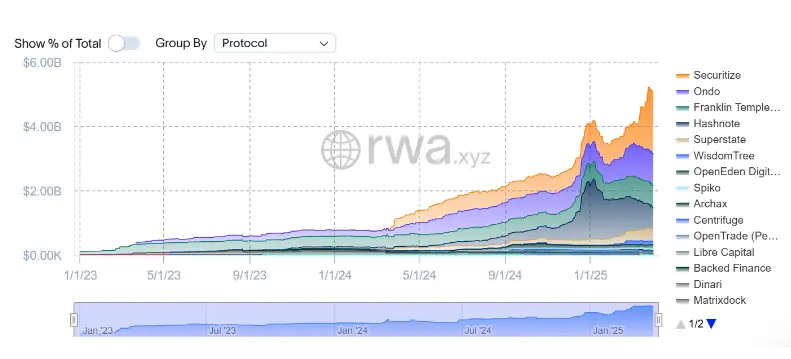
Ondo, with U.S. Treasuries as its underlying asset, offers a yield of 4.25% for its USDY aimed at non-U.S. retail customers and OUSG aimed at U.S. institutional qualified clients. It is a leader in the RWA sector in terms of multi-chain support and ecological applications, but it is slightly lacking in regulatory compliance compared to Franklin Templeton's FOBXX and BlackRock's BUIDL. Meanwhile, the Usual protocol, which has emerged strongly in this cycle, has added liquidity tokens USD0++ on top of a basket of U.S. Treasuries as its underlying asset, providing liquidity for 4-year locked U.S. Treasuries, similar to how Lido does for Ethereum staking, and allowing participation in stablecoin liquidity mining or lending pools for additional returns.
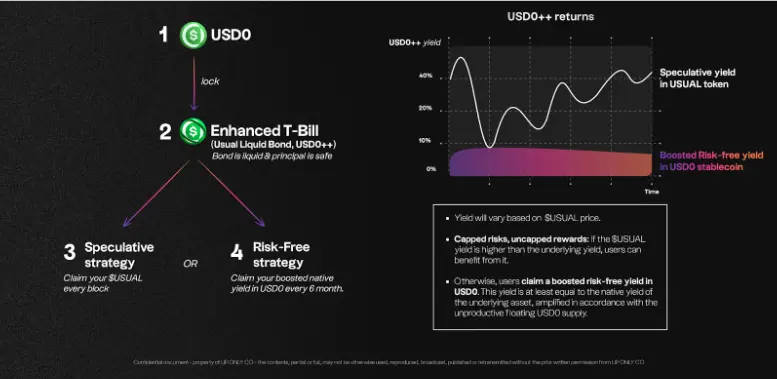
It is important to note that most U.S. Treasury RWA projects have stable yields around 4%, while the higher yields of Usual's stablecoin pool mainly come from Usual token subsidies, Pills (Point) incentives, liquidity mining, and other speculative additional returns, which are not sustainable. As the most complete RWA project in the DeFi ecosystem, it still faces the risk of slowly declining yields in the future, but it is unlikely to experience a catastrophic failure.
Although the price decoupling and sell-off event caused by the adjustment of the redemption mechanism for USD0++ in early 2025 stemmed from a misalignment between its bond attributes and market expectations, compounded by governance errors, its liquidity design mechanism remains an industry innovation worth referencing for other U.S. Treasury RWA projects.
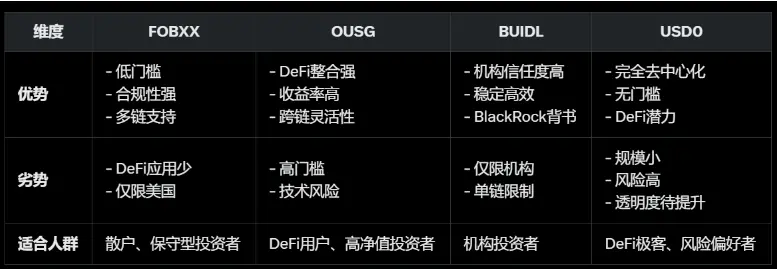
5. Structured Products
Currently, structured products and dual-currency strategies popular on most centralized exchanges originate from options trading strategies like "selling options to earn premiums," specifically Sell Put or Sell Call strategies. U-based stablecoins primarily utilize the Sell Put strategy, with returns coming from the premiums paid by option buyers, i.e., earning stable USDT option premiums or purchasing BTC or ETH at lower target prices.
In practical application, selling options strategies are more suitable for range-bound markets, with Sell Put target prices set at the lower limit of the range and Sell Call target prices at the upper limit. For a unidirectional bullish market, the returns from option premiums are limited, making it more appropriate to choose Buy Call. In a unidirectional bearish market, Sell Put can lead to continuous losses after buying at a mid-point. Newcomers to selling options trading may fall into the trap of pursuing short-term "high option premium returns" while neglecting the risk exposure from significant price declines. However, setting the target price too low can make the option premium returns unattractive. Based on my years of options trading experience, the Sell Put strategy is mainly employed when market panic spreads during downturns, setting lower buy target prices to earn high option premium returns, while during market uptrends, choosing exchange flexible lending yields is more favorable.

As for the recently popular Shark Fin principal protection strategy on exchanges like OKX, it employs a Bear Call Spread strategy (Sell Call to collect option premiums + Buy Call at a higher strike price to limit upside) combined with a Bull Put Spread (Sell Put to collect option premiums + Buy Put at a lower strike price to limit downside), allowing the entire options portfolio to earn option premium returns within a range. Outside the range, buying and selling options hedge each other without additional returns. For users who prioritize principal safety and do not seek to maximize option premiums or currency-based returns, this is a suitable U-based financial solution.
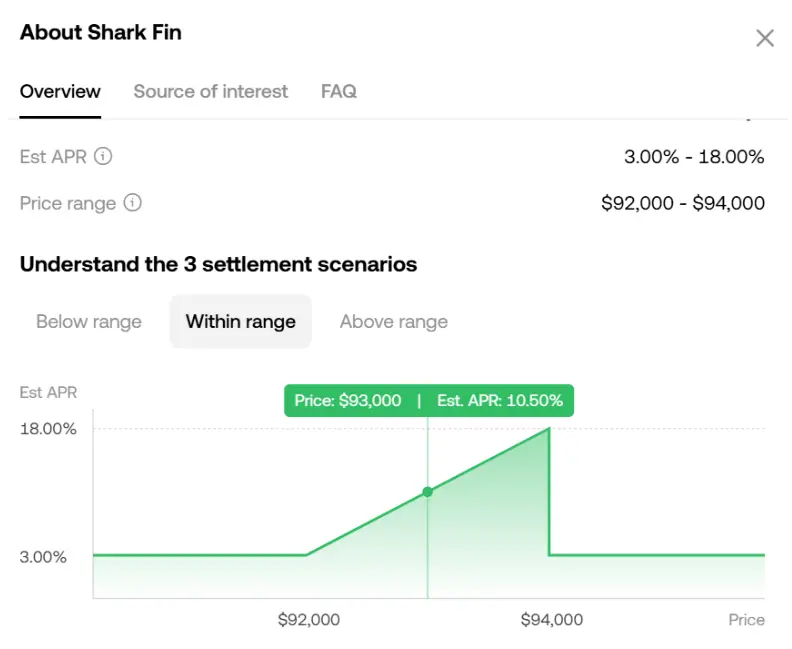
The maturity of on-chain options is still under development. Ribbon Finance was once the leading options vault protocol in the last cycle, and top on-chain options trading platforms like Opyn and Lyra Finance also allow manual trading of option premium strategies, but they are no longer as prominent as before.
6. Yield Tokenization
The Pendle protocol, highly representative of this cycle, began with fixed-rate lending in 2020 and evolved into yield tokenization in 2024. By splitting yield assets into different components, it allows users to lock in fixed returns, speculate on future yields, or hedge yield risks.
- Standardized Yield Tokens (SY) can be split into Principal Tokens (PT) and Yield Tokens (YT).
- PT (Principal Token): Represents the principal portion of the underlying asset, redeemable at 1:1 for the base asset at maturity.
- YT (Yield Token): Represents the future yield portion, decreasing over time, with a value of zero at maturity.
Pendle's trading strategies mainly include:
- Fixed Income: Holding PT until maturity to receive fixed returns, suitable for risk-averse individuals.
- Yield Speculation: Purchasing YT to bet on future yield increases, suitable for risk-tolerant individuals.
- Risk Hedging: Selling YT to lock in current yields and avoid market downturn risks.
- Liquidity Provision: Users can deposit PT and YT into liquidity pools to earn trading fees and PENDLE rewards.
Currently, its main stablecoin pool not only includes the native yield from the underlying assets but also adds speculative YT returns, LP returns, Pendle token incentives, and Points, making its overall yield attractive. One downside is that Pendle's high-yield pools generally have shorter terms, requiring frequent on-chain operations to switch yield pools, unlike staking or liquidity mining or lending pools, which can be set up once for ongoing returns.
7. A Basket of Stablecoin Yield Products:
Ether.Fi, as the leading protocol for Liquid Restaking, has actively embraced change and transformed its product offerings to launch various yield products in BTC, ETH, and stablecoins after entering a saturated downward trend in the Restaking sector, maintaining its leading position in the entire DeFi industry.
In its stablecoin Market-Neutral USD pool, it provides users with a basket of stablecoin yield products in the form of actively managed funds, including lending interest (Syrup, Morpho, Aave), liquidity mining (Curve), funding rate arbitrage (Ethena), and yield tokenization (Pendle). For users seeking stable on-chain yields, with insufficient capital and unwilling to operate frequently, this is a method that balances high returns and diversified risks.

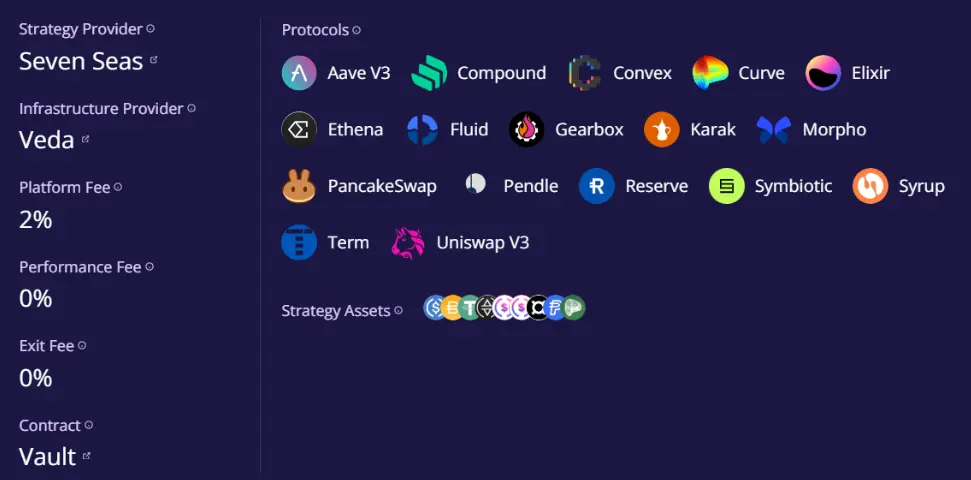
8. Stablecoin Staking Yields:
Stablecoin assets do not possess staking attributes like ETH on POS public chains. However, the Arweave team has launched the AO network, which accepts on-chain staking of stETH and DAI under the Fair Launch token issuance model, with DAI staking offering the highest AO yield capital efficiency. We can categorize this type of stablecoin staking model as an alternative stablecoin yield model, ensuring the safety of DAI assets while earning additional AO token rewards for a small investment, with the core risk lying in the development of the AO network and the uncertainty of token prices.
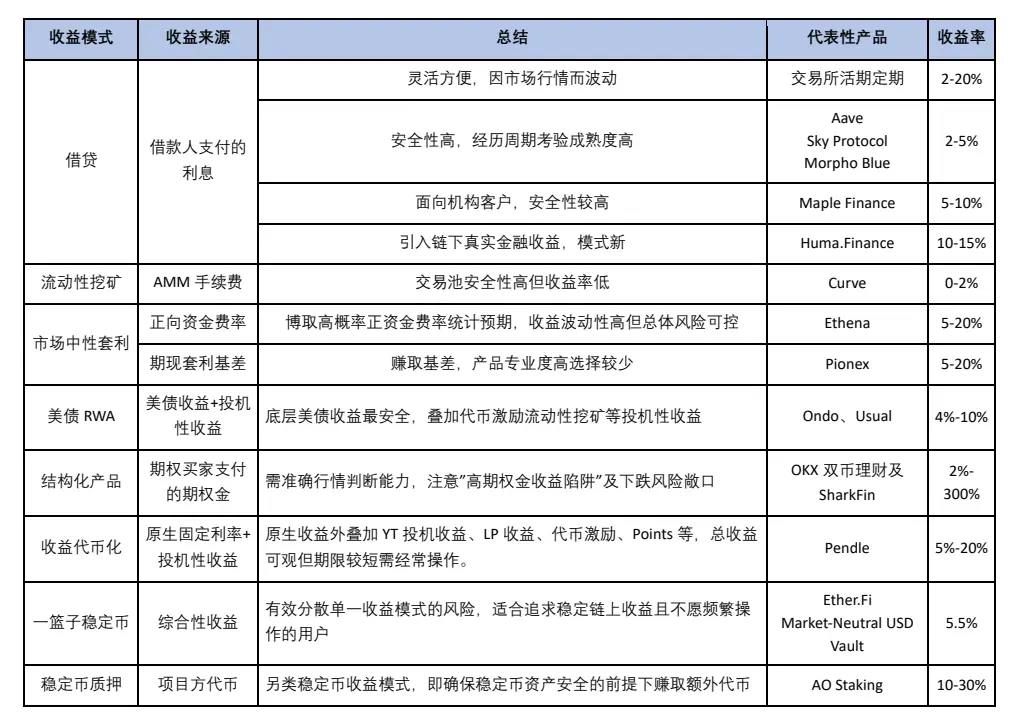
In summary, we have summarized the mainstream stablecoin yield models currently in the cryptocurrency market in the table above. Stablecoin assets are the most familiar yet easily overlooked market for cryptocurrency practitioners. Understanding the sources of stablecoin yields and making reasonable allocations can help better cope with the uncertainties and risks in the cryptocurrency market on a solid financial foundation.
免责声明:本文章仅代表作者个人观点,不代表本平台的立场和观点。本文章仅供信息分享,不构成对任何人的任何投资建议。用户与作者之间的任何争议,与本平台无关。如网页中刊载的文章或图片涉及侵权,请提供相关的权利证明和身份证明发送邮件到support@aicoin.com,本平台相关工作人员将会进行核查。




